Review Literature on Inflammatory Reaction of Brain and Role of IL-33, IL-16, and CD4
VerifiedAdded on 2023/06/09
|8
|2015
|241
AI Summary
This review literature discusses the inflammatory reaction of the brain and the role of IL-33, IL-16, and CD4 in neurodegenerative diseases like Alzheimer's. It also highlights the mode of action of IL-33 and IL-16 as alarmin cytokines and the mechanical properties of CD4 cells.
Contribute Materials
Your contribution can guide someone’s learning journey. Share your
documents today.

Running head: REVIEW LITERATURE.
REVIEW LITERATURE
Name of the Student
Name of the University
Author Note
REVIEW LITERATURE
Name of the Student
Name of the University
Author Note
Secure Best Marks with AI Grader
Need help grading? Try our AI Grader for instant feedback on your assignments.
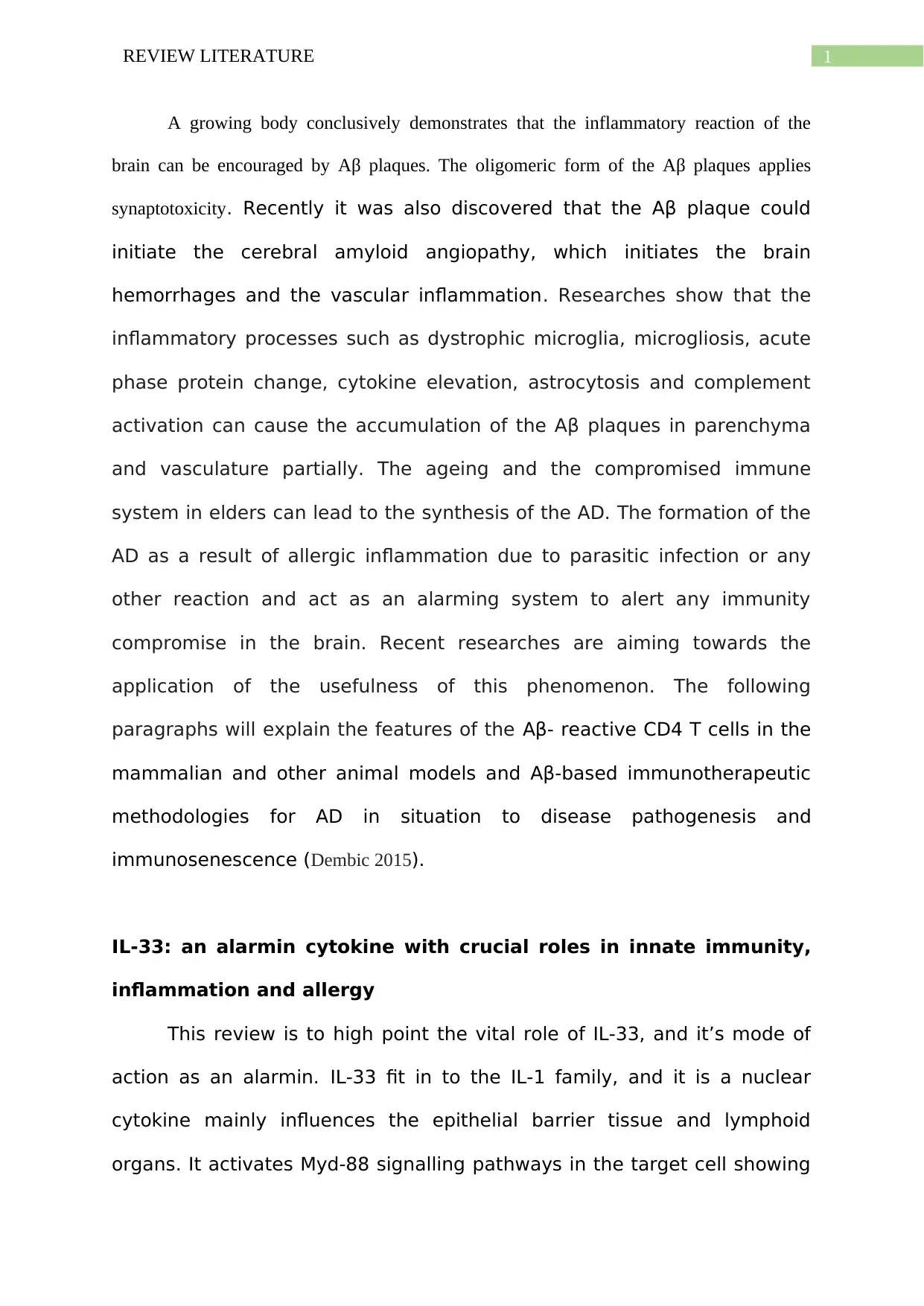
1REVIEW LITERATURE
A growing body conclusively demonstrates that the inflammatory reaction of the
brain can be encouraged by Aβ plaques. The oligomeric form of the Aβ plaques applies
synaptotoxicity. Recently it was also discovered that the Aβ plaque could
initiate the cerebral amyloid angiopathy, which initiates the brain
hemorrhages and the vascular inflammation. Researches show that the
inflammatory processes such as dystrophic microglia, microgliosis, acute
phase protein change, cytokine elevation, astrocytosis and complement
activation can cause the accumulation of the Aβ plaques in parenchyma
and vasculature partially. The ageing and the compromised immune
system in elders can lead to the synthesis of the AD. The formation of the
AD as a result of allergic inflammation due to parasitic infection or any
other reaction and act as an alarming system to alert any immunity
compromise in the brain. Recent researches are aiming towards the
application of the usefulness of this phenomenon. The following
paragraphs will explain the features of the Aβ- reactive CD4 T cells in the
mammalian and other animal models and Aβ-based immunotherapeutic
methodologies for AD in situation to disease pathogenesis and
immunosenescence (Dembic 2015).
IL-33: an alarmin cytokine with crucial roles in innate immunity,
inflammation and allergy
This review is to high point the vital role of IL-33, and it’s mode of
action as an alarmin. IL-33 fit in to the IL-1 family, and it is a nuclear
cytokine mainly influences the epithelial barrier tissue and lymphoid
organs. It activates Myd-88 signalling pathways in the target cell showing
A growing body conclusively demonstrates that the inflammatory reaction of the
brain can be encouraged by Aβ plaques. The oligomeric form of the Aβ plaques applies
synaptotoxicity. Recently it was also discovered that the Aβ plaque could
initiate the cerebral amyloid angiopathy, which initiates the brain
hemorrhages and the vascular inflammation. Researches show that the
inflammatory processes such as dystrophic microglia, microgliosis, acute
phase protein change, cytokine elevation, astrocytosis and complement
activation can cause the accumulation of the Aβ plaques in parenchyma
and vasculature partially. The ageing and the compromised immune
system in elders can lead to the synthesis of the AD. The formation of the
AD as a result of allergic inflammation due to parasitic infection or any
other reaction and act as an alarming system to alert any immunity
compromise in the brain. Recent researches are aiming towards the
application of the usefulness of this phenomenon. The following
paragraphs will explain the features of the Aβ- reactive CD4 T cells in the
mammalian and other animal models and Aβ-based immunotherapeutic
methodologies for AD in situation to disease pathogenesis and
immunosenescence (Dembic 2015).
IL-33: an alarmin cytokine with crucial roles in innate immunity,
inflammation and allergy
This review is to high point the vital role of IL-33, and it’s mode of
action as an alarmin. IL-33 fit in to the IL-1 family, and it is a nuclear
cytokine mainly influences the epithelial barrier tissue and lymphoid
organs. It activates Myd-88 signalling pathways in the target cell showing
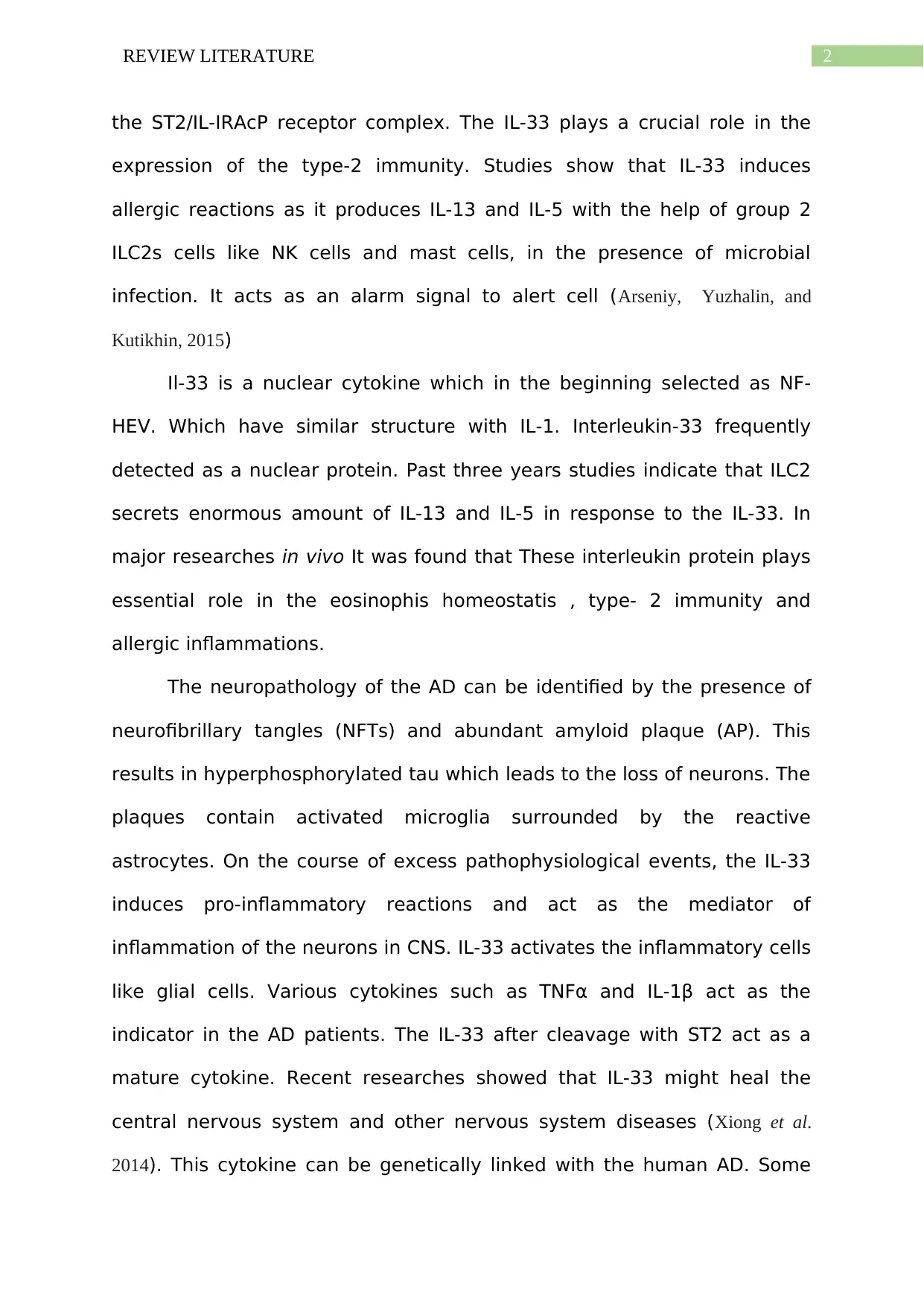
2REVIEW LITERATURE
the ST2/IL-IRAcP receptor complex. The IL-33 plays a crucial role in the
expression of the type-2 immunity. Studies show that IL-33 induces
allergic reactions as it produces IL-13 and IL-5 with the help of group 2
ILC2s cells like NK cells and mast cells, in the presence of microbial
infection. It acts as an alarm signal to alert cell (Arseniy, Yuzhalin, and
Kutikhin, 2015)
Il-33 is a nuclear cytokine which in the beginning selected as NF-
HEV. Which have similar structure with IL-1. Interleukin-33 frequently
detected as a nuclear protein. Past three years studies indicate that ILC2
secrets enormous amount of IL-13 and IL-5 in response to the IL-33. In
major researches in vivo It was found that These interleukin protein plays
essential role in the eosinophis homeostatis , type- 2 immunity and
allergic inflammations.
The neuropathology of the AD can be identified by the presence of
neurofibrillary tangles (NFTs) and abundant amyloid plaque (AP). This
results in hyperphosphorylated tau which leads to the loss of neurons. The
plaques contain activated microglia surrounded by the reactive
astrocytes. On the course of excess pathophysiological events, the IL-33
induces pro-inflammatory reactions and act as the mediator of
inflammation of the neurons in CNS. IL-33 activates the inflammatory cells
like glial cells. Various cytokines such as TNFα and IL-1β act as the
indicator in the AD patients. The IL-33 after cleavage with ST2 act as a
mature cytokine. Recent researches showed that IL-33 might heal the
central nervous system and other nervous system diseases (Xiong et al.
2014). This cytokine can be genetically linked with the human AD. Some
the ST2/IL-IRAcP receptor complex. The IL-33 plays a crucial role in the
expression of the type-2 immunity. Studies show that IL-33 induces
allergic reactions as it produces IL-13 and IL-5 with the help of group 2
ILC2s cells like NK cells and mast cells, in the presence of microbial
infection. It acts as an alarm signal to alert cell (Arseniy, Yuzhalin, and
Kutikhin, 2015)
Il-33 is a nuclear cytokine which in the beginning selected as NF-
HEV. Which have similar structure with IL-1. Interleukin-33 frequently
detected as a nuclear protein. Past three years studies indicate that ILC2
secrets enormous amount of IL-13 and IL-5 in response to the IL-33. In
major researches in vivo It was found that These interleukin protein plays
essential role in the eosinophis homeostatis , type- 2 immunity and
allergic inflammations.
The neuropathology of the AD can be identified by the presence of
neurofibrillary tangles (NFTs) and abundant amyloid plaque (AP). This
results in hyperphosphorylated tau which leads to the loss of neurons. The
plaques contain activated microglia surrounded by the reactive
astrocytes. On the course of excess pathophysiological events, the IL-33
induces pro-inflammatory reactions and act as the mediator of
inflammation of the neurons in CNS. IL-33 activates the inflammatory cells
like glial cells. Various cytokines such as TNFα and IL-1β act as the
indicator in the AD patients. The IL-33 after cleavage with ST2 act as a
mature cytokine. Recent researches showed that IL-33 might heal the
central nervous system and other nervous system diseases (Xiong et al.
2014). This cytokine can be genetically linked with the human AD. Some
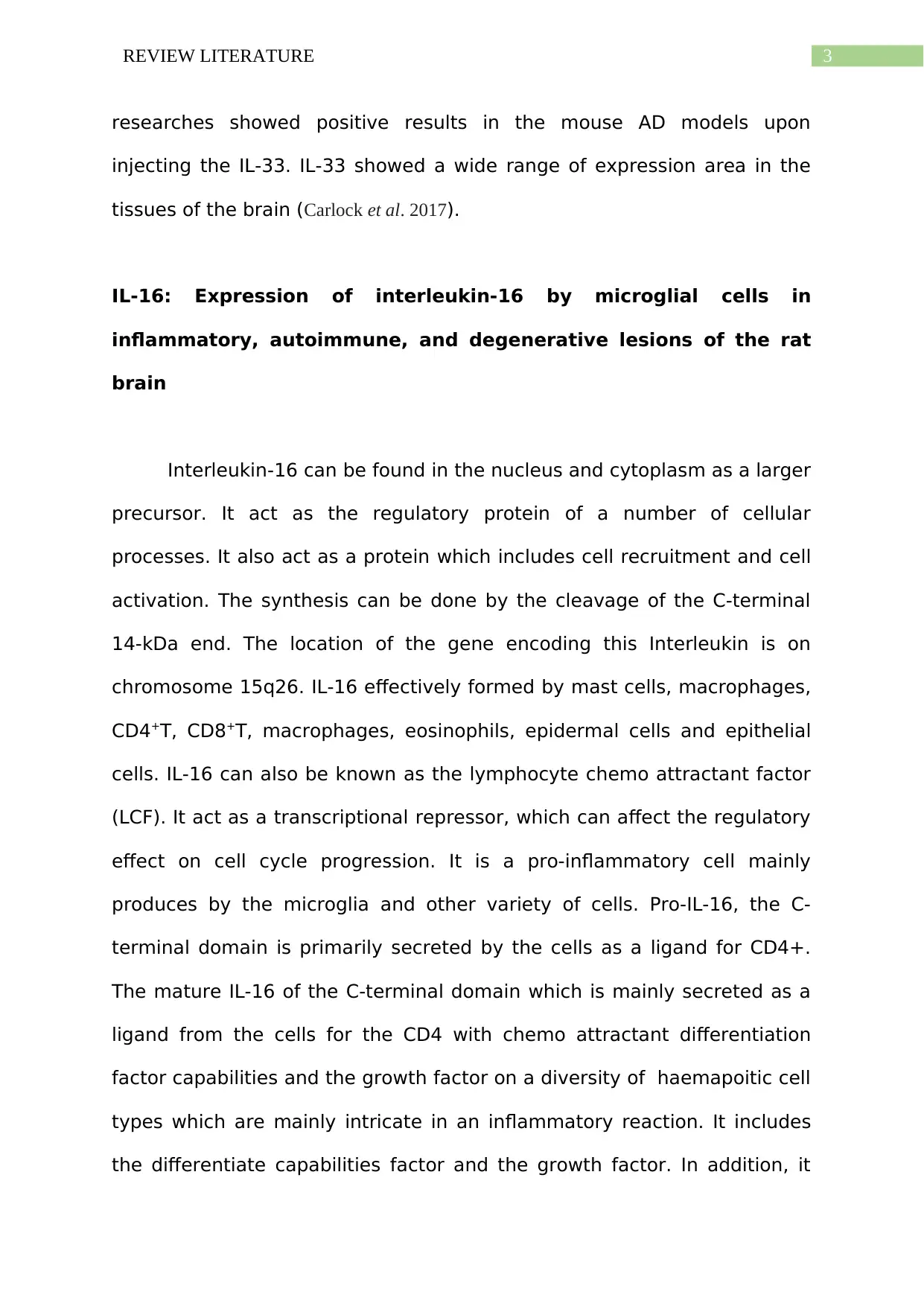
3REVIEW LITERATURE
researches showed positive results in the mouse AD models upon
injecting the IL-33. IL-33 showed a wide range of expression area in the
tissues of the brain (Carlock et al. 2017).
IL-16: Expression of interleukin-16 by microglial cells in
inflammatory, autoimmune, and degenerative lesions of the rat
brain
Interleukin-16 can be found in the nucleus and cytoplasm as a larger
precursor. It act as the regulatory protein of a number of cellular
processes. It also act as a protein which includes cell recruitment and cell
activation. The synthesis can be done by the cleavage of the C-terminal
14-kDa end. The location of the gene encoding this Interleukin is on
chromosome 15q26. IL-16 effectively formed by mast cells, macrophages,
CD4+T, CD8+T, macrophages, eosinophils, epidermal cells and epithelial
cells. IL-16 can also be known as the lymphocyte chemo attractant factor
(LCF). It act as a transcriptional repressor, which can affect the regulatory
effect on cell cycle progression. It is a pro-inflammatory cell mainly
produces by the microglia and other variety of cells. Pro-IL-16, the C-
terminal domain is primarily secreted by the cells as a ligand for CD4+.
The mature IL-16 of the C-terminal domain which is mainly secreted as a
ligand from the cells for the CD4 with chemo attractant differentiation
factor capabilities and the growth factor on a diversity of haemapoitic cell
types which are mainly intricate in an inflammatory reaction. It includes
the differentiate capabilities factor and the growth factor. In addition, it
researches showed positive results in the mouse AD models upon
injecting the IL-33. IL-33 showed a wide range of expression area in the
tissues of the brain (Carlock et al. 2017).
IL-16: Expression of interleukin-16 by microglial cells in
inflammatory, autoimmune, and degenerative lesions of the rat
brain
Interleukin-16 can be found in the nucleus and cytoplasm as a larger
precursor. It act as the regulatory protein of a number of cellular
processes. It also act as a protein which includes cell recruitment and cell
activation. The synthesis can be done by the cleavage of the C-terminal
14-kDa end. The location of the gene encoding this Interleukin is on
chromosome 15q26. IL-16 effectively formed by mast cells, macrophages,
CD4+T, CD8+T, macrophages, eosinophils, epidermal cells and epithelial
cells. IL-16 can also be known as the lymphocyte chemo attractant factor
(LCF). It act as a transcriptional repressor, which can affect the regulatory
effect on cell cycle progression. It is a pro-inflammatory cell mainly
produces by the microglia and other variety of cells. Pro-IL-16, the C-
terminal domain is primarily secreted by the cells as a ligand for CD4+.
The mature IL-16 of the C-terminal domain which is mainly secreted as a
ligand from the cells for the CD4 with chemo attractant differentiation
factor capabilities and the growth factor on a diversity of haemapoitic cell
types which are mainly intricate in an inflammatory reaction. It includes
the differentiate capabilities factor and the growth factor. In addition, it
Secure Best Marks with AI Grader
Need help grading? Try our AI Grader for instant feedback on your assignments.
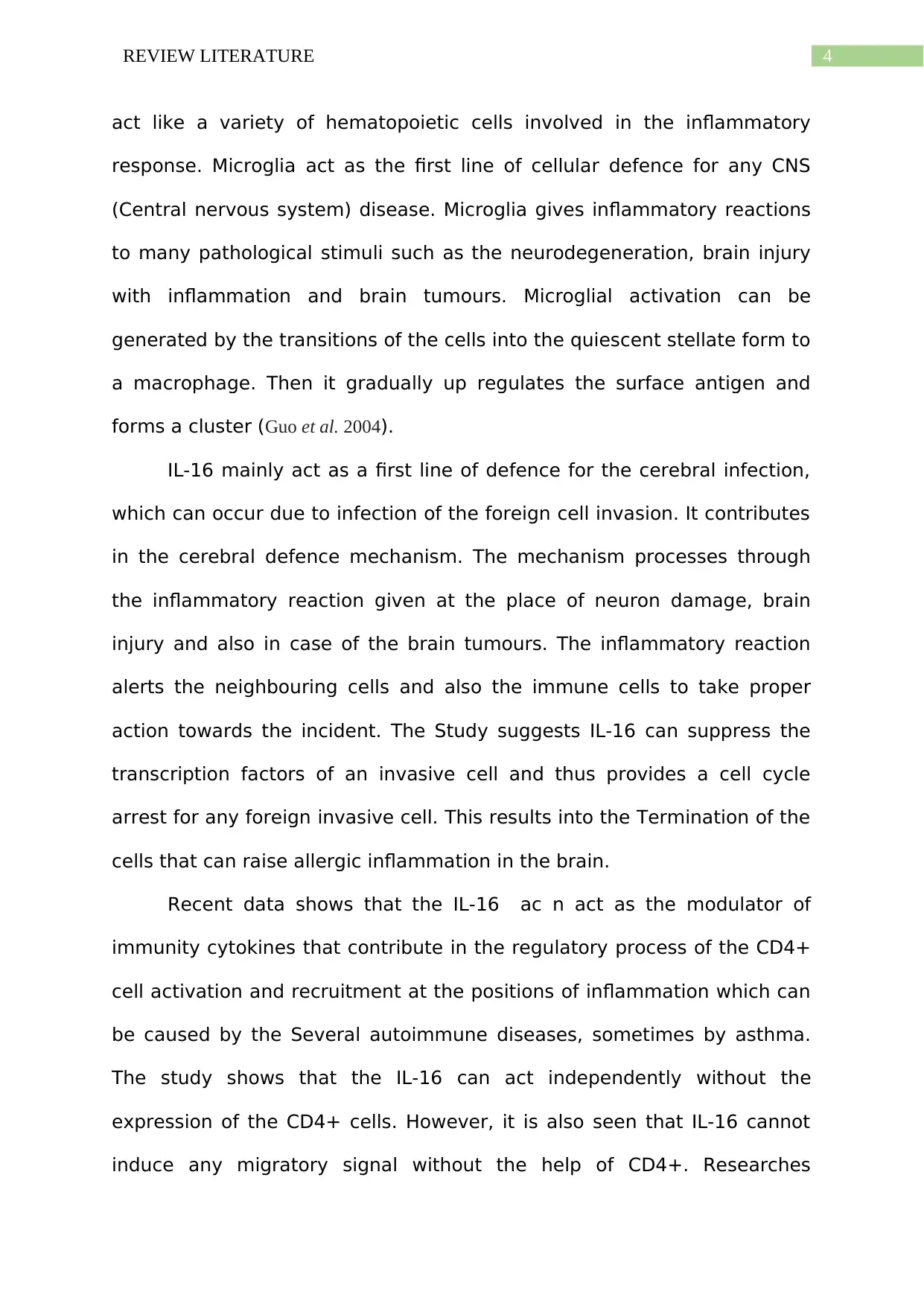
4REVIEW LITERATURE
act like a variety of hematopoietic cells involved in the inflammatory
response. Microglia act as the first line of cellular defence for any CNS
(Central nervous system) disease. Microglia gives inflammatory reactions
to many pathological stimuli such as the neurodegeneration, brain injury
with inflammation and brain tumours. Microglial activation can be
generated by the transitions of the cells into the quiescent stellate form to
a macrophage. Then it gradually up regulates the surface antigen and
forms a cluster (Guo et al. 2004).
IL-16 mainly act as a first line of defence for the cerebral infection,
which can occur due to infection of the foreign cell invasion. It contributes
in the cerebral defence mechanism. The mechanism processes through
the inflammatory reaction given at the place of neuron damage, brain
injury and also in case of the brain tumours. The inflammatory reaction
alerts the neighbouring cells and also the immune cells to take proper
action towards the incident. The Study suggests IL-16 can suppress the
transcription factors of an invasive cell and thus provides a cell cycle
arrest for any foreign invasive cell. This results into the Termination of the
cells that can raise allergic inflammation in the brain.
Recent data shows that the IL-16 ac n act as the modulator of
immunity cytokines that contribute in the regulatory process of the CD4+
cell activation and recruitment at the positions of inflammation which can
be caused by the Several autoimmune diseases, sometimes by asthma.
The study shows that the IL-16 can act independently without the
expression of the CD4+ cells. However, it is also seen that IL-16 cannot
induce any migratory signal without the help of CD4+. Researches
act like a variety of hematopoietic cells involved in the inflammatory
response. Microglia act as the first line of cellular defence for any CNS
(Central nervous system) disease. Microglia gives inflammatory reactions
to many pathological stimuli such as the neurodegeneration, brain injury
with inflammation and brain tumours. Microglial activation can be
generated by the transitions of the cells into the quiescent stellate form to
a macrophage. Then it gradually up regulates the surface antigen and
forms a cluster (Guo et al. 2004).
IL-16 mainly act as a first line of defence for the cerebral infection,
which can occur due to infection of the foreign cell invasion. It contributes
in the cerebral defence mechanism. The mechanism processes through
the inflammatory reaction given at the place of neuron damage, brain
injury and also in case of the brain tumours. The inflammatory reaction
alerts the neighbouring cells and also the immune cells to take proper
action towards the incident. The Study suggests IL-16 can suppress the
transcription factors of an invasive cell and thus provides a cell cycle
arrest for any foreign invasive cell. This results into the Termination of the
cells that can raise allergic inflammation in the brain.
Recent data shows that the IL-16 ac n act as the modulator of
immunity cytokines that contribute in the regulatory process of the CD4+
cell activation and recruitment at the positions of inflammation which can
be caused by the Several autoimmune diseases, sometimes by asthma.
The study shows that the IL-16 can act independently without the
expression of the CD4+ cells. However, it is also seen that IL-16 cannot
induce any migratory signal without the help of CD4+. Researches
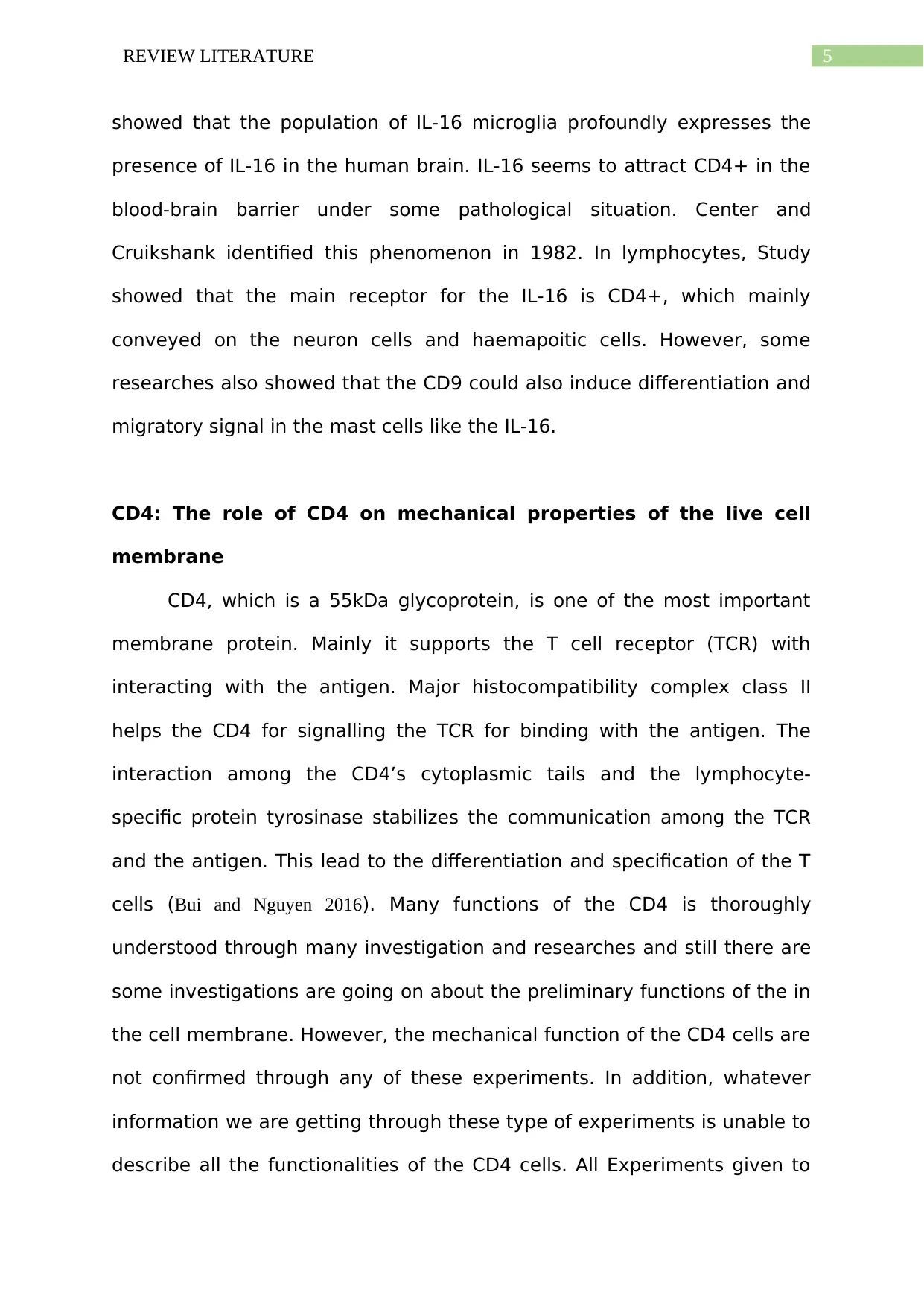
5REVIEW LITERATURE
showed that the population of IL-16 microglia profoundly expresses the
presence of IL-16 in the human brain. IL-16 seems to attract CD4+ in the
blood-brain barrier under some pathological situation. Center and
Cruikshank identified this phenomenon in 1982. In lymphocytes, Study
showed that the main receptor for the IL-16 is CD4+, which mainly
conveyed on the neuron cells and haemapoitic cells. However, some
researches also showed that the CD9 could also induce differentiation and
migratory signal in the mast cells like the IL-16.
CD4: The role of CD4 on mechanical properties of the live cell
membrane
CD4, which is a 55kDa glycoprotein, is one of the most important
membrane protein. Mainly it supports the T cell receptor (TCR) with
interacting with the antigen. Major histocompatibility complex class II
helps the CD4 for signalling the TCR for binding with the antigen. The
interaction among the CD4’s cytoplasmic tails and the lymphocyte-
specific protein tyrosinase stabilizes the communication among the TCR
and the antigen. This lead to the differentiation and specification of the T
cells (Bui and Nguyen 2016). Many functions of the CD4 is thoroughly
understood through many investigation and researches and still there are
some investigations are going on about the preliminary functions of the in
the cell membrane. However, the mechanical function of the CD4 cells are
not confirmed through any of these experiments. In addition, whatever
information we are getting through these type of experiments is unable to
describe all the functionalities of the CD4 cells. All Experiments given to
showed that the population of IL-16 microglia profoundly expresses the
presence of IL-16 in the human brain. IL-16 seems to attract CD4+ in the
blood-brain barrier under some pathological situation. Center and
Cruikshank identified this phenomenon in 1982. In lymphocytes, Study
showed that the main receptor for the IL-16 is CD4+, which mainly
conveyed on the neuron cells and haemapoitic cells. However, some
researches also showed that the CD9 could also induce differentiation and
migratory signal in the mast cells like the IL-16.
CD4: The role of CD4 on mechanical properties of the live cell
membrane
CD4, which is a 55kDa glycoprotein, is one of the most important
membrane protein. Mainly it supports the T cell receptor (TCR) with
interacting with the antigen. Major histocompatibility complex class II
helps the CD4 for signalling the TCR for binding with the antigen. The
interaction among the CD4’s cytoplasmic tails and the lymphocyte-
specific protein tyrosinase stabilizes the communication among the TCR
and the antigen. This lead to the differentiation and specification of the T
cells (Bui and Nguyen 2016). Many functions of the CD4 is thoroughly
understood through many investigation and researches and still there are
some investigations are going on about the preliminary functions of the in
the cell membrane. However, the mechanical function of the CD4 cells are
not confirmed through any of these experiments. In addition, whatever
information we are getting through these type of experiments is unable to
describe all the functionalities of the CD4 cells. All Experiments given to
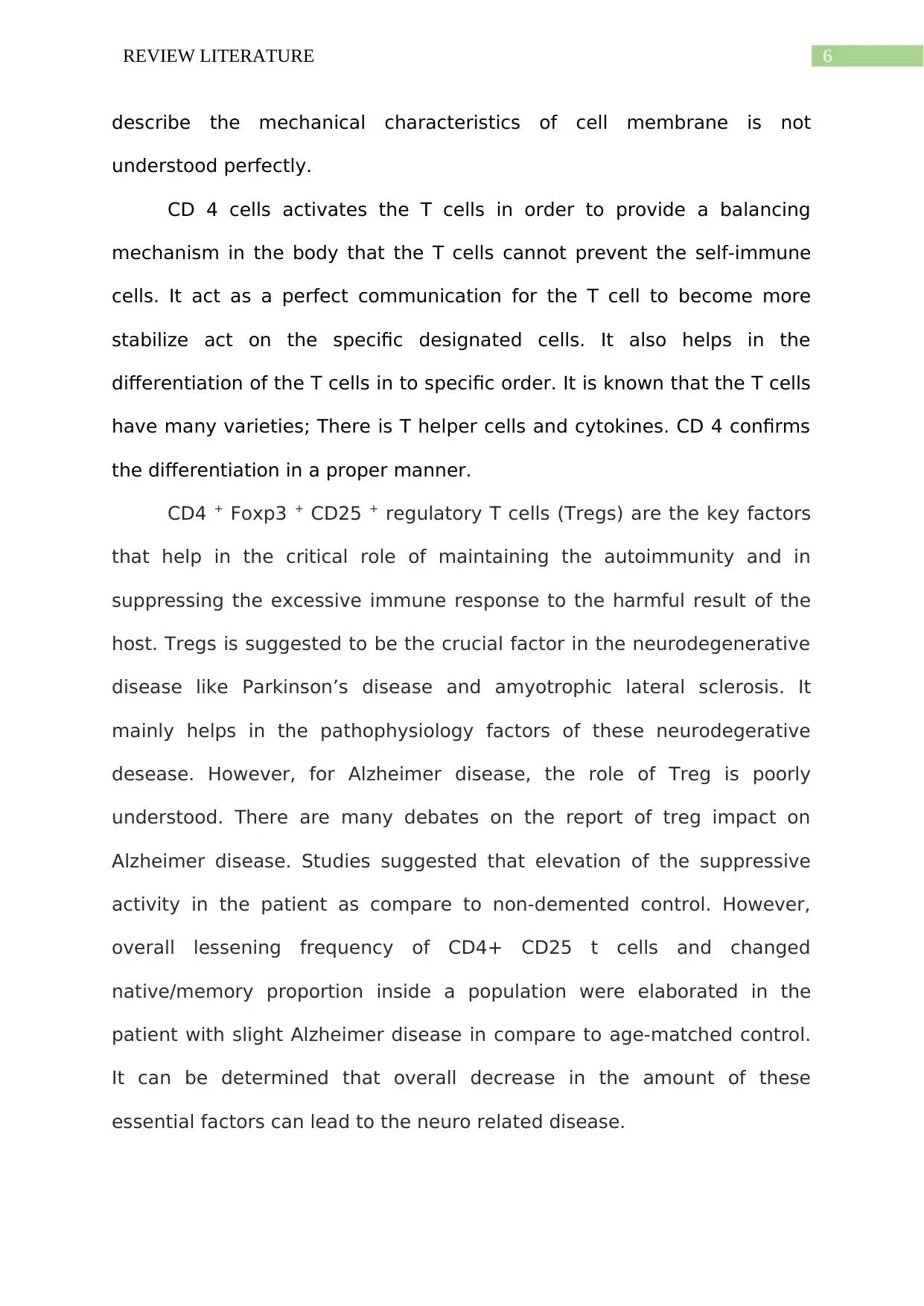
6REVIEW LITERATURE
describe the mechanical characteristics of cell membrane is not
understood perfectly.
CD 4 cells activates the T cells in order to provide a balancing
mechanism in the body that the T cells cannot prevent the self-immune
cells. It act as a perfect communication for the T cell to become more
stabilize act on the specific designated cells. It also helps in the
differentiation of the T cells in to specific order. It is known that the T cells
have many varieties; There is T helper cells and cytokines. CD 4 confirms
the differentiation in a proper manner.
CD4 + Foxp3 + CD25 + regulatory T cells (Tregs) are the key factors
that help in the critical role of maintaining the autoimmunity and in
suppressing the excessive immune response to the harmful result of the
host. Tregs is suggested to be the crucial factor in the neurodegenerative
disease like Parkinson’s disease and amyotrophic lateral sclerosis. It
mainly helps in the pathophysiology factors of these neurodegerative
desease. However, for Alzheimer disease, the role of Treg is poorly
understood. There are many debates on the report of treg impact on
Alzheimer disease. Studies suggested that elevation of the suppressive
activity in the patient as compare to non-demented control. However,
overall lessening frequency of CD4+ CD25 t cells and changed
native/memory proportion inside a population were elaborated in the
patient with slight Alzheimer disease in compare to age-matched control.
It can be determined that overall decrease in the amount of these
essential factors can lead to the neuro related disease.
describe the mechanical characteristics of cell membrane is not
understood perfectly.
CD 4 cells activates the T cells in order to provide a balancing
mechanism in the body that the T cells cannot prevent the self-immune
cells. It act as a perfect communication for the T cell to become more
stabilize act on the specific designated cells. It also helps in the
differentiation of the T cells in to specific order. It is known that the T cells
have many varieties; There is T helper cells and cytokines. CD 4 confirms
the differentiation in a proper manner.
CD4 + Foxp3 + CD25 + regulatory T cells (Tregs) are the key factors
that help in the critical role of maintaining the autoimmunity and in
suppressing the excessive immune response to the harmful result of the
host. Tregs is suggested to be the crucial factor in the neurodegenerative
disease like Parkinson’s disease and amyotrophic lateral sclerosis. It
mainly helps in the pathophysiology factors of these neurodegerative
desease. However, for Alzheimer disease, the role of Treg is poorly
understood. There are many debates on the report of treg impact on
Alzheimer disease. Studies suggested that elevation of the suppressive
activity in the patient as compare to non-demented control. However,
overall lessening frequency of CD4+ CD25 t cells and changed
native/memory proportion inside a population were elaborated in the
patient with slight Alzheimer disease in compare to age-matched control.
It can be determined that overall decrease in the amount of these
essential factors can lead to the neuro related disease.
Paraphrase This Document
Need a fresh take? Get an instant paraphrase of this document with our AI Paraphraser
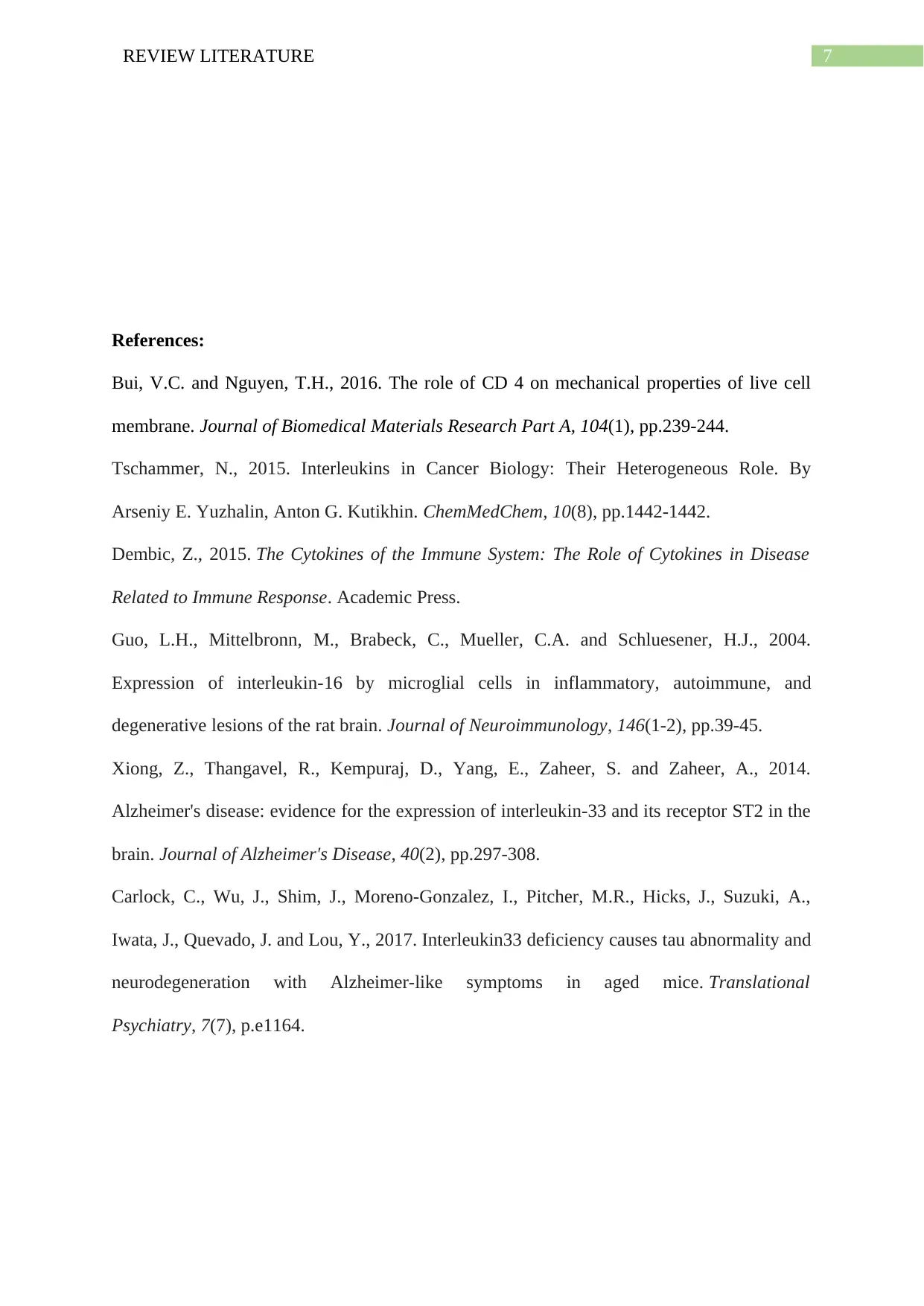
7REVIEW LITERATURE
References:
Bui, V.C. and Nguyen, T.H., 2016. The role of CD 4 on mechanical properties of live cell
membrane. Journal of Biomedical Materials Research Part A, 104(1), pp.239-244.
Tschammer, N., 2015. Interleukins in Cancer Biology: Their Heterogeneous Role. By
Arseniy E. Yuzhalin, Anton G. Kutikhin. ChemMedChem, 10(8), pp.1442-1442.
Dembic, Z., 2015. The Cytokines of the Immune System: The Role of Cytokines in Disease
Related to Immune Response. Academic Press.
Guo, L.H., Mittelbronn, M., Brabeck, C., Mueller, C.A. and Schluesener, H.J., 2004.
Expression of interleukin-16 by microglial cells in inflammatory, autoimmune, and
degenerative lesions of the rat brain. Journal of Neuroimmunology, 146(1-2), pp.39-45.
Xiong, Z., Thangavel, R., Kempuraj, D., Yang, E., Zaheer, S. and Zaheer, A., 2014.
Alzheimer's disease: evidence for the expression of interleukin-33 and its receptor ST2 in the
brain. Journal of Alzheimer's Disease, 40(2), pp.297-308.
Carlock, C., Wu, J., Shim, J., Moreno-Gonzalez, I., Pitcher, M.R., Hicks, J., Suzuki, A.,
Iwata, J., Quevado, J. and Lou, Y., 2017. Interleukin33 deficiency causes tau abnormality and
neurodegeneration with Alzheimer-like symptoms in aged mice. Translational
Psychiatry, 7(7), p.e1164.
References:
Bui, V.C. and Nguyen, T.H., 2016. The role of CD 4 on mechanical properties of live cell
membrane. Journal of Biomedical Materials Research Part A, 104(1), pp.239-244.
Tschammer, N., 2015. Interleukins in Cancer Biology: Their Heterogeneous Role. By
Arseniy E. Yuzhalin, Anton G. Kutikhin. ChemMedChem, 10(8), pp.1442-1442.
Dembic, Z., 2015. The Cytokines of the Immune System: The Role of Cytokines in Disease
Related to Immune Response. Academic Press.
Guo, L.H., Mittelbronn, M., Brabeck, C., Mueller, C.A. and Schluesener, H.J., 2004.
Expression of interleukin-16 by microglial cells in inflammatory, autoimmune, and
degenerative lesions of the rat brain. Journal of Neuroimmunology, 146(1-2), pp.39-45.
Xiong, Z., Thangavel, R., Kempuraj, D., Yang, E., Zaheer, S. and Zaheer, A., 2014.
Alzheimer's disease: evidence for the expression of interleukin-33 and its receptor ST2 in the
brain. Journal of Alzheimer's Disease, 40(2), pp.297-308.
Carlock, C., Wu, J., Shim, J., Moreno-Gonzalez, I., Pitcher, M.R., Hicks, J., Suzuki, A.,
Iwata, J., Quevado, J. and Lou, Y., 2017. Interleukin33 deficiency causes tau abnormality and
neurodegeneration with Alzheimer-like symptoms in aged mice. Translational
Psychiatry, 7(7), p.e1164.
1 out of 8
Your All-in-One AI-Powered Toolkit for Academic Success.
+13062052269
info@desklib.com
Available 24*7 on WhatsApp / Email
![[object Object]](/_next/static/media/star-bottom.7253800d.svg)
Unlock your academic potential
© 2024 | Zucol Services PVT LTD | All rights reserved.